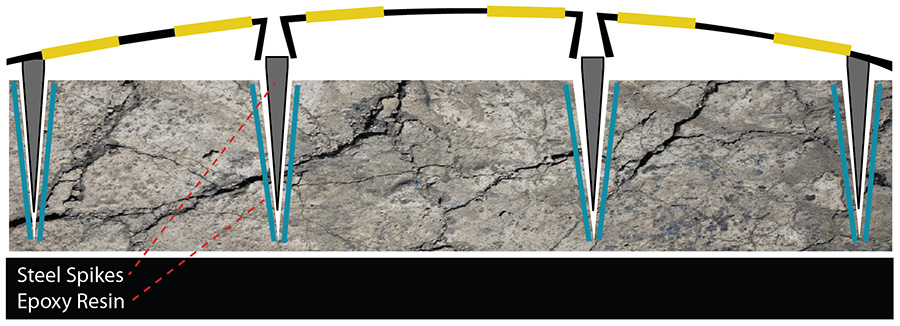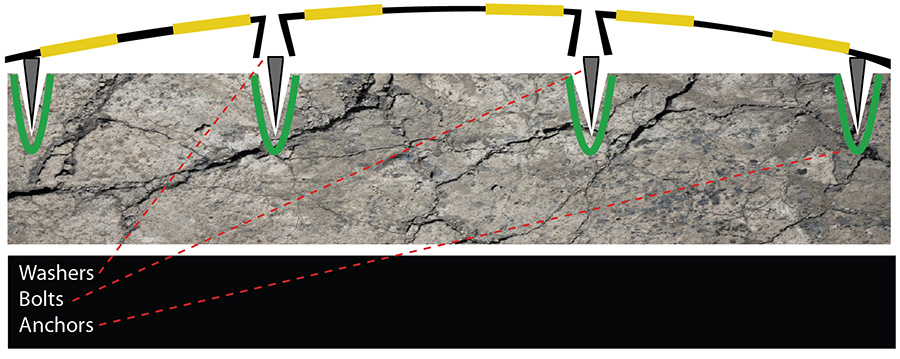Speed bumps are becoming one of the most popular road products for commercial and residential areas, often clients wonder if they are easy to install and they ask us always this question: How to install rubber speed bumps?
In this article we will give you a guide step by step so you will find the answer on How do you install rubber speed bumps? Also the answer will be given about how to install speed bumps in asphalt and how to install speed bumps in concrete in addition we will over the topic of How much does it cost to put in a speed bump? You will find a complete Speed Bump and hump installation guide.
But first lets describes some important facts about speed bumps. Speed bumps are used to slow cars down to 2-5 mph, making parking lots safer for pedestrians, cyclists, and drivers, they are very easy to install. Our heavy-duty economy speed bump measurement for each middle section length is 72″ and weighs around 48 lbs. Unimat 6 foot Economy Rubber Speed Bumps are constructed with high quality. These 6 foot economy rubber speed bumps are designed to reduce and control the speed of vehicles in parking lots, schools, parking areas and roadways. Our speed bumps include high visibility yellow stripes which are molded into the speed bump for durability and embedded glass reflectors for increased visibility. These middle sections can be joined with end caps to form a complete speed bump. They are easily cut to custom lengths to fit any area, also they are weather and chemical resistant.
Rubber Speed Bumps Manufacturer
We are Manufacturer that is why we have the best prices and we also have different packages for
Distributors and Suppliers, you can single units or Wholesale.
We have clients all over the world, we are fully stocked and can ship right away.
Our customer service representatives are always ready to assist you and can answer any technical and specific questions.
Unimat Traffic prices are the lowest of the market.
| SKU | Description | Length | Height | Width | Weight |
|---|---|---|---|---|---|
| SB206FT | 6 Ft Speed Bump (1) 6′ Section With no End Caps | 72″ | 2″ | 12″ | 48.40 |
| SB207FT | 7 Ft Speed Bump (1) 6′ Section + (2) End Caps | 86″ | 2″ | 12″ | 55.40 |
| SB213FT | Single Lane 12 Ft Speed Bump (2) 6′ Section With no End Caps | 144″ | 2″ | 12″ | 96.80 |
| SB219FT | Double lane 19 Ft Speed Bump (3) 6′ Section + (2) End Caps | 230″ | 2″ | 12″ | 152.20 |
| SB225FT | 25 Ft Speed Bump (4) 6′ Section + (2) End Caps | 302″ | 2″ | 12″ | 200.60 |
| SB2ECAP | End cap | 7′ | 2′ | 12′ | 3.50 |
| SKU | Description | Length | Height | Width | Weight |
|---|---|---|---|---|---|
| SB3039I | 39″ Speed Bump (1) 39″ Section With no End Caps | 39″ | 2″ | 13.7″ | 36.20 |
| SB3117I | 117″ Single Lane Speed Bump (3) 39″ Sections With no End Caps | 117″ | 2″ | 13.7″ | 108.60 |
| SB3137I | 137″ Single Lane Speed Bump (3) 39″ Sections + (2) End Caps | 137″ | 2″ | 13.7″ | 124.20 |
| SB3234I | 234″ Double lane Speed Bump (6) 39″ Sections With no End Caps | 234″ | 2″ | 13.7″ | 217.20 |
| SB3254I-2 | 254″ Double Lane Speed Bump (6) 39″ Sections + (2) End Caps | 254″ | 2″ | 13.7″ | 232.80 |
| SB3ECAP-2 | End cap | 10″ | 2″ | 13.7″ | 7.80 |
| SKU | Description | Length | Height | Width | Weight |
|---|---|---|---|---|---|
| SH1018I | 18.75″ Speed Bump (1) 18.75″ Section with no End Caps | 18.75″ | 1.25″ | 2″ | 22.20 |
| SH1112I | 112.5″ Single Lane Speed Bump (6) 18.75″ Sections with no End Caps | 112.5″ | 1.25″ | 2″ | 133.20 |
| SH1128I | 10 Ft Single Lane Speed Bump (6) 18.75″ Sections + (2) End Caps | 128.5 | 1.25″ | 2″ | 148.80 |
| SH1225I | 225″ Double Lane Speed Bump (12) 18.75″ Sections with no End Caps | 225″ | 1.25″ | 2″ | 266.40 |
| SH1241I | 20 Ft Double Lane Speed Bump (12) 18.75″ Sections + (2) End Caps | 241″ | 1.25″ | 2″ | 282.00 |
| SH1ECAL | LEFT End Cap | 8″ | 1.25″ | 2′ | 7.80 |
| SH1ECAR | RIGHT End Cap | 8″ | 1.25″ | 2′ | 7.80 |
| SKU | Description | Length | Height | Width | Weight |
|---|---|---|---|---|---|
| SH2019I | 19.75″ Speed Bump (1) 19.75″ Section With no End Caps | 19.75″ | 2″ | 3″ | 48.00 |
| SH2121I | 10 Ft Single Lane Speed Bump (5) 19.75″ Sections + (2) End Caps | 121.75″ | 2″ | 3″ | 273.00 |
| SH2240I | 20 Ft Double Lane Speed Bump (11) 19.75″ + (2) End Caps | 240″ | 2″ | 3″ | 561.00 |
| SH2ECAL | LEFT End cap | 11.5″ | 2″ | 3′ | 16.00 |
| SH2ECAR | RIGHT End cap | 11.5″ | 2″ | 3′ | 16.00 |
What do you need to install speed bumps in asphalt?
- Steel spikes (we provide the hardware in our low price)
- Hammer High-speed and small sledge
- Activated epoxy resin (this is not necessary jut recommended)
Now that you have the necessary equipment please follow these steps:
A) Determine the location of the Speed hump and sweep the surface clean of
debris / dust. Use chalk to mark the center lines (parallel and
perpendicular to the direction of the street) and border lines on the surface.
B) Assemble and position the units, starting from the center line (parallel to
the direction of the street).
C) Drill 12MM diameter holes into the surface, through the existing holes of
the placed units. The holes should be 120-140MM deep in order to
accommodate the plastic shields that are 100MM long.
D) Make sure the holes are clear of dust and debris before installing the
shields. After each hole is drilled, insert a plastic shield in order to keep
the units from shifting.
E) Insert the bolts and steel washers into the product installation holes and
tighten every element.
Here is an illustration of how the installation on the ground will look like:
What do you need to install speed bumps in concrete?
- Steel spikes (we provide the hardware in our low price)
- Hammer High-speed and small sledge
- Activated epoxy resin (this is not necessary but recommended)
Now that you have the necessary equipment please follow these steps:
A) Determine the location of the Speed hump and sweep the surface clean of
debris / dust. Use chalk to mark the center lines (parallel and
perpendicular to the direction of the street) and border lines on the surface.
B) Assemble and position the units, starting from the center line (parallel to
the direction of the street).
C) Drill 12MM diameter holes into the surface, through the existing holes of
the placed units. The holes should be 120-140MM deep in order to
accommodate the plastic shields that are 100MM long.
D) Make sure the holes are clear of dust and debris before installing the
shields. After each hole is drilled, insert a plastic shield in order to keep
the units from shifting.
E) Insert the bolts and steel washers into the product installation holes and
tighten every element.
Here is an illustration of how the installation on the ground will look like:
As you can see performing the installation of speed bumps and humps are very easy and very cost effective, you can have them installed in less than one hour with very minimum and basic tools.
Once speed bumps have been installed you will immediately start seeing the great benefits of this products, some of them are:
- Made with high quality EPDM rubber compound, 25% recycled rubber content.
- Free hardware included for asphalt or concrete installation.
- Build your own system with 6 ft. sections and 7″ end caps.
- Molded-in cat eye reflectors and bright yellow EPDM rubber offer hight visibility.
- Slows vehicles to 5 MPH.
- Speed bump system comes in 6ft., 7 ft., 12 ft., 19 ft., and 25 ft. sizes.
- Easy to install, easy removal for storage or relocation.
- It can be used as a 2-channel cable protector and as a speed bump.
- ideal for residential, commercial, industrial areas, parks, sporting venues, school zones, etc.
- Great quality durable rubber construction with yellow safety strips that will not fade.
- Non-skid surface.
- Durable bright yellow embedded EPDM rubber strip.
- Available with end cap parts (sold individually) very easy to attach.
- Mounting Holes (4) x 1-1/2, Countersink, 1/2 Mount Hole.
Speed bump anchors will definitely make this product very secure to the ground, anchoring Speed Bumps to Asphalt is a very easy task to accomplish by doing this you will maintain a safe pedestrian environment by slowing down vehicle traffic with our 6′ Speed Bump. Asphalt anchor for speed bump and hump are one of the most common applications in the market, we have a very popular demand on this type of ground then followed by Concrete Anchor for Speed Bump and Hump. Both systems being very secure and also easy to install. Here in our company we have an incredible advantage we provide you with the hardware in our very low prices, our prices are the lowest in the market and they include the hardware, the 6 foot speed bump can permanently be installed on asphalt or concrete using its pre-drilled countersink mounting holes. Maintain a safe pedestrian environment by slowing down vehicle traffic with our great 6’ heavy-duty economy speed bumps. Our products will give you total satisfaction and your roads will be safe and people as well, areas like parking lots and much more will be protected. Please call one of our sale representatives right away and ask for you quote!



